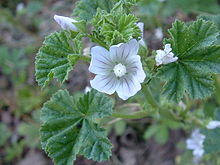
The Malvales are an order of flowering plants. As circumscribed by APG II-system, the order includes about 6000 species within nine families. The order is placed in the eurosids II, which are part of the eudicots.

Malvaceae, or the mallows, is a family of flowering plants estimated to contain 244 genera with 4225 known species. Well-known members of economic importance include okra, cotton, cacao, roselle and durian. There are also some genera containing familiar ornamentals, such as Alcea (hollyhock), Malva (mallow), and Tilia. The genera with the largest numbers of species include Hibiscus, Pavonia, Sida, Ayenia, Dombeya, and Sterculia.

Bombacaceae were long recognised as a family of flowering plants or Angiospermae. The family name was based on the type genus Bombax. As is true for many botanical names, circumscription and status of the taxon has varied with taxonomic point of view, and currently the preference is to transfer most of the erstwhile family Bombacaceae to the subfamily Bombacoideae within the family Malvaceae in the order Malvales. The rest of the family were transferred to other taxa, notably the new family Durionaceae. Irrespective of current taxonomic status, many of the species originally included in the Bombacaceae are of considerable ecological, historical, horticultural, and economic importance, such as balsa, kapok, baobab and durian.

Kosteletzkya is a genus of the plant family Malvaceae that includes the seashore mallow. It includes about 27 species found worldwide.
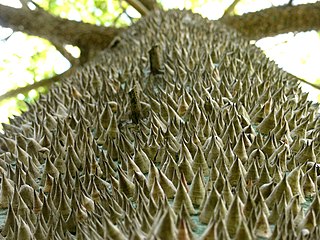
Bombacoideae is a subfamily of the mallow family, Malvaceae. It contains herbaceous and woody plants. Their leaves are alternate, commonly palmately lobed, with small and caducous stipules. The flowers are hermaphroditic and actinomorphic; the calyx has 5 sepals united at the base, which are not accompanied by an epicalyx (involucel). The corolla has 5 free petals and an androecium of numerous stamens, typically with free filaments which are not fused in a staminal tube (column). The pollen is smooth and the ovary superior and pluricarpellate. The fruits are schizocarpous or capsular.
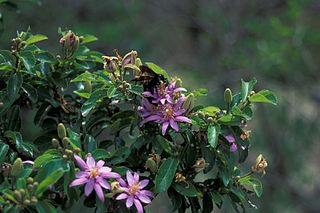
Grewioideae is a subfamily of the family Malvaceae and was first described by Hochreutiner. The group is named after its type genus, Grewia, which is named for the English scientist Nehemiah Grew (1641–1712). It contains a number of genera that were previously placed in the defunct family Tiliaceae.

Alyogyne is a genus of flowering plants in the family Malvaceae which are endemic to Australia. Its species were formerly in the genus Hibiscus but were split off starting in 1863 with H. hakaeifolius. In 1915 Lewton transferred H. cuneiformis and in Fryxell (1968) H. pinonianus and H. huegelii followed. A recent revision has created many new species.

Lagunaria is a genus in the family Malvaceae. It is an Australian plant which is native to Lord Howe Island, Norfolk Island and parts of coastal Queensland. It has been introduced to many parts of the world. The genus was named for its resemblance to the earlier genus Laguna Cav., which was named in honour of Andrés Laguna, a Spanish botanist and a physician to Pope Julius III.
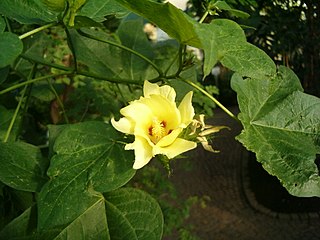
Gossypieae is a tribe of the flowering plant subfamily Malvoideae. It includes the cotton (Gossypium) and related plants. It is distinguished from the Hibisceae on the basis of embryo structure and its apparently unique possession of glands able to synthesize the pigment gossypol.

Hibisceae is a tribe of flowering plants in the mallow family Malvaceae, subfamily Malvoideae.
Lyndley Alan Craven was a botanist who became the Principal Research Scientist of the Australian National Herbarium.

Puccinia malvacearum, also known as hollyhock or mallow rust, is a fungal species within the genus Puccinia known for attacking members of the family Malvaceae. An autoecious pathogen, it can complete its life cycle using a single host.

Malveae is a tribe of flowering plants in the mallow family Malvaceae, subfamily Malvoideae. The tribe circumscribes approximately 70 genera and 1040 species and has the greatest species diversity out the three tribes that make up Malvoideae. The flowers of Malveae are five-merous with a characteristic staminal column, a trait found throughout Malvoideae. Although there are not many economically important species within Malveae, the tribe includes Althaea officinalis, otherwise known as the marsh-mallow.
Macrostelia is a genus in the tribe Hibisceae - in the family Malvaceae. The genus consists of three species: M. calyculata Hochr., M. involucrata Hochr., and M. laurina (Baill.) Hochr. & Humbert. Macrostelias - all native to Madagascar - distinguish themselves from most other genera in Hibisceae by typically bearing flowers with a long corolla tube. Although members of Hibiscus - an example of one of these other genera - may bear flowers with proximally connate petals, such connation occurs only at the very base of the petals.
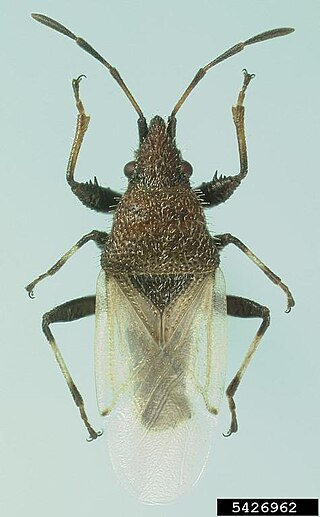
Oxycarenus hyalinipennis, common name cotton seed bug, is a species of plant bug belonging to the family Lygaeidae, subfamily Oxycareninae.
Durioneae is a tribe within the subfamily Helicteroideae of the plant family Malvaceae s.l. The tribe contains at least five genera, including Durio, the genus of tree species that produce Durian fruits.

Plagianthus is a genus of flowering plants confined to New Zealand and the Chatham Islands. The familial placement of the genus was controversial for many years, but modern genetic studies show it definitely belongs in the Malvaceae subfamily Malvoideae. The name means "slanted flowers".
Papuodendron is a genus of flowering plants belonging to the family Malvaceae. In 1946 Cyril Tenison White described its first species, Papuodendron lepidotum, which was discovered growing in 1944 in the Mandated Territory of New Guinea. Its native range is New Guinea.
